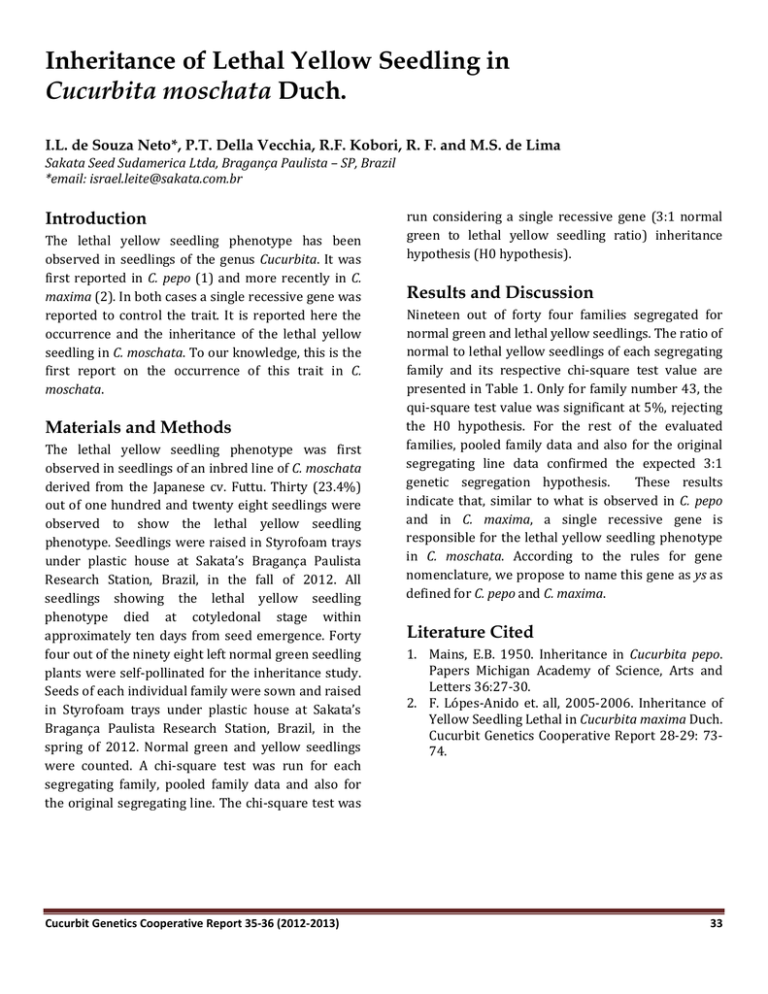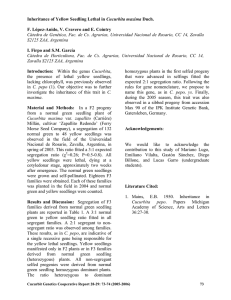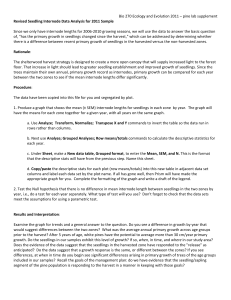Inheritance of Lethal Yellow Seedling in Cucurbita moschata Introduction
advertisement

Inheritance of Lethal Yellow Seedling in Cucurbita moschata Duch. I.L. de Souza Neto*, P.T. Della Vecchia, R.F. Kobori, R. F. and M.S. de Lima Sakata Seed Sudamerica Ltda, Bragança Paulista – SP, Brazil *email: israel.leite@sakata.com.br Introduction The lethal yellow seedling phenotype has been observed in seedlings of the genus Cucurbita. It was first reported in C. pepo (1) and more recently in C. maxima (2). In both cases a single recessive gene was reported to control the trait. It is reported here the occurrence and the inheritance of the lethal yellow seedling in C. moschata. To our knowledge, this is the first report on the occurrence of this trait in C. moschata. Materials and Methods The lethal yellow seedling phenotype was first observed in seedlings of an inbred line of C. moschata derived from the Japanese cv. Futtu. Thirty (23.4%) out of one hundred and twenty eight seedlings were observed to show the lethal yellow seedling phenotype. Seedlings were raised in Styrofoam trays under plastic house at Sakata’s Bragança Paulista Research Station, Brazil, in the fall of 2012. All seedlings showing the lethal yellow seedling phenotype died at cotyledonal stage within approximately ten days from seed emergence. Forty four out of the ninety eight left normal green seedling plants were self-pollinated for the inheritance study. Seeds of each individual family were sown and raised in Styrofoam trays under plastic house at Sakata’s Bragança Paulista Research Station, Brazil, in the spring of 2012. Normal green and yellow seedlings were counted. A chi-square test was run for each segregating family, pooled family data and also for the original segregating line. The chi-square test was Cucurbit Genetics Cooperative Report 35-36 (2012-2013) run considering a single recessive gene (3:1 normal green to lethal yellow seedling ratio) inheritance hypothesis (H0 hypothesis). Results and Discussion Nineteen out of forty four families segregated for normal green and lethal yellow seedlings. The ratio of normal to lethal yellow seedlings of each segregating family and its respective chi-square test value are presented in Table 1. Only for family number 43, the qui-square test value was significant at 5%, rejecting the H0 hypothesis. For the rest of the evaluated families, pooled family data and also for the original segregating line data confirmed the expected 3:1 genetic segregation hypothesis. These results indicate that, similar to what is observed in C. pepo and in C. maxima, a single recessive gene is responsible for the lethal yellow seedling phenotype in C. moschata. According to the rules for gene nomenclature, we propose to name this gene as ys as defined for C. pepo and C. maxima. Literature Cited 1. Mains, E.B. 1950. Inheritance in Cucurbita pepo. Papers Michigan Academy of Science, Arts and Letters 36:27-30. 2. F. Lópes-Anido et. all, 2005-2006. Inheritance of Yellow Seedling Lethal in Cucurbita maxima Duch. Cucurbit Genetics Cooperative Report 28-29: 7374. 33 Table 1: Expected and observed normal green to lethal yellow seedlings for C. moschata families derived from the Japanese cv. Futtu and their respectively chi-square test values. Expected number of Observed number of seedlings seedlings Family P-value X2 number (%) Green Lethal Green Lethal Yellow Yellow 1 18 6 20 4 0.89 34.58 ns 2 15 5 13 7 1.07 30.17 ns 3 15 5 17 3 1.07 30.17 ns 7 15 5 16 4 0.27 60.56 ns 10 14.25 4.75 12 7 1.42 23.32 ns 12 15 5 16 4 0.27 60.56 ns 13 12.75 4.25 15 2 1.59 20.76 ns 17 17.25 5.75 20 3 1.75 18.54 ns 22 18 6 15 9 2.00 15.73 ns 23 18 6 21 3 2.00 15.73 ns 26 18 6 18 6 0.00 100.0 ns 28 18 6 17 7 0.22 63.73 ns 31 12.75 4.25 13 4 0.02 88.86 ns 33 18 6 17 7 0.22 63.73 ns 36 11.25 3.75 12 3 0.20 65.47 ns 38 18 6 18 6 0.00 100 ns 39 15 5 16 4 0.27 60.56 ns 42 18 6 16 8 0.89 34.58 ns 43 18 6 13 11 5.55 1.84 * Pooled Data 305.25 101.75 305 102 0.01 97.72 ns O. L.1 96 32 98 30 0.17 68.31 ns Total 401.25 133.75 403 132 0.03 86.13 ns 1= Original Line; ns= no significant at 5%; *= significant at 5%. Pictures: Normal and lethal yellow seedlings in C. moschata. Cucurbit Genetics Cooperative Report 35-36 (2012-2013) 34





